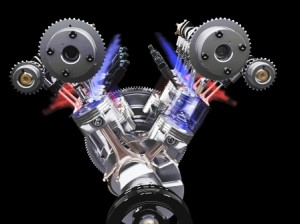Ford Motor Company has applied for 125 patents for the technology surrounding the EcoBoost engines, which feature expensive direct-injection of fuel and turbocharging that have long been in use at other automakers.
“The secret to Ford’s EcoBoost system isn’t just the hardware – the key is in the Ford control system,” said Brett Hinds, Ford Advanced Engine Design and Development manager. “Our engineers have the right ‘recipes’ to integrate the various systems like engine, transmission and fuel management, resulting in a seamless, exhilarating driving experience,” he said.
The powertrain management techniques make up the bulk of the technology’s patents said Hinds. Ford licenses hybrid management control technologies from Toyota Motor Company.
Ford’s powertrain management strategy uses hundreds of thousands of lines of computer code and related parameters that are adjusted to optimize the engine and transmission operation. In all, the powertrain management strategy uses 10,066 adjustable parameters. It is not clear how this compares to the control strategies in use at other automakers.
While the engine is at idle each fuel injector releases 10.4 milligrams of fuel per injection or 1/25,000 the volume of a can of soda or 0.2 drops of fuel, while fuel injection pressure ranges between 220 psi and 2150 psi. Injection timing is adjusted up to 300 times a second.
“It’s these processes that largely make up the EcoBoost patent contribution and make Ford’s use of direct injection and turbocharging of its engines like no other automaker in the world,” claimed Hinds.
Bill Coughlin, president and CEO of Ford Global Technologies, a wholly owned subsidiary responsible for managing Ford’s intellectual property worldwide, said, “We focus on getting high-quality patents that have the best breakthrough potential for the company.”
The 2010 Ford Fusion and Fusion Hybrid, which is America’s most fuel-efficient midsize sedan, have 119 patents to date and more are pending, said Coughlin, who noted Global Technologies also is responsible for the company’s current storehouse of 4,618 active as well as thousands of pending U.S. patents.
Ford also highlighted the findings of a 2008 study by the world’s leading patent analyst – The Patent Board – which found that Ford outperformed all other automakers in the quality and significance of its technology patents.
“Ford’s patented technologies are closer to the cutting edge than its competitors,” says Christine Wren, director of business development for The Patent Board, which tracks and analyzes patents across 17 industries globally. Neither company said if Ford is a customer of The Patent Board.
The study’s findings were potentially significant because it contradicted comments by a wide array of analysts suggesting Ford had fallen behind in technology. The study indicates that Ford has actually outperformed key rivals such as General Motors, Toyota Motor, Volkswagen and Daimler in bringing new technology on line.
In the marketplace, however, Ford clearly lagged behind competitors in such critical area as overhead camshaft engines, hybrid technology, common rail diesel engines, multi-speed automatic transmissions, and small car development. The company’s attempt to produce a breakthrough in continuously variable transmissions for a mid-size car ended in failure a few years back.


There is one particular point in the article that I would take issue with: Ford allegedly lagging behind competitors in overhead camshaft engines. While this may have been true in the past with respect to Japanese and European competitors, it certainly isn’t enymore. It’s my understanding that all of Ford’s current engines are OHC and have been for some time. On the other hand, aren’t the majority of GM and Chrysler engines still using pushrods? Ford has been the hands down leader in this area among the U.S. big three.
Ford stuck with a pushrod V6 engine in the Taurus, once its volume seller, until it was canceled.
And what year was that last Taurus pushrod motor? What current Fords, GMs, and Chryslers have pushrod engines? I hear that Chevrolet is serious about pushing forward with plans for an overhead cam engine in the 2011 Corvette. The Dodge Viper probably won’t ever get one though. I stick by my statement that Ford was way ahead of its Detroit rivals on this one.
It was the fall of 2006 when the Atlanta plant built the last Taurus.